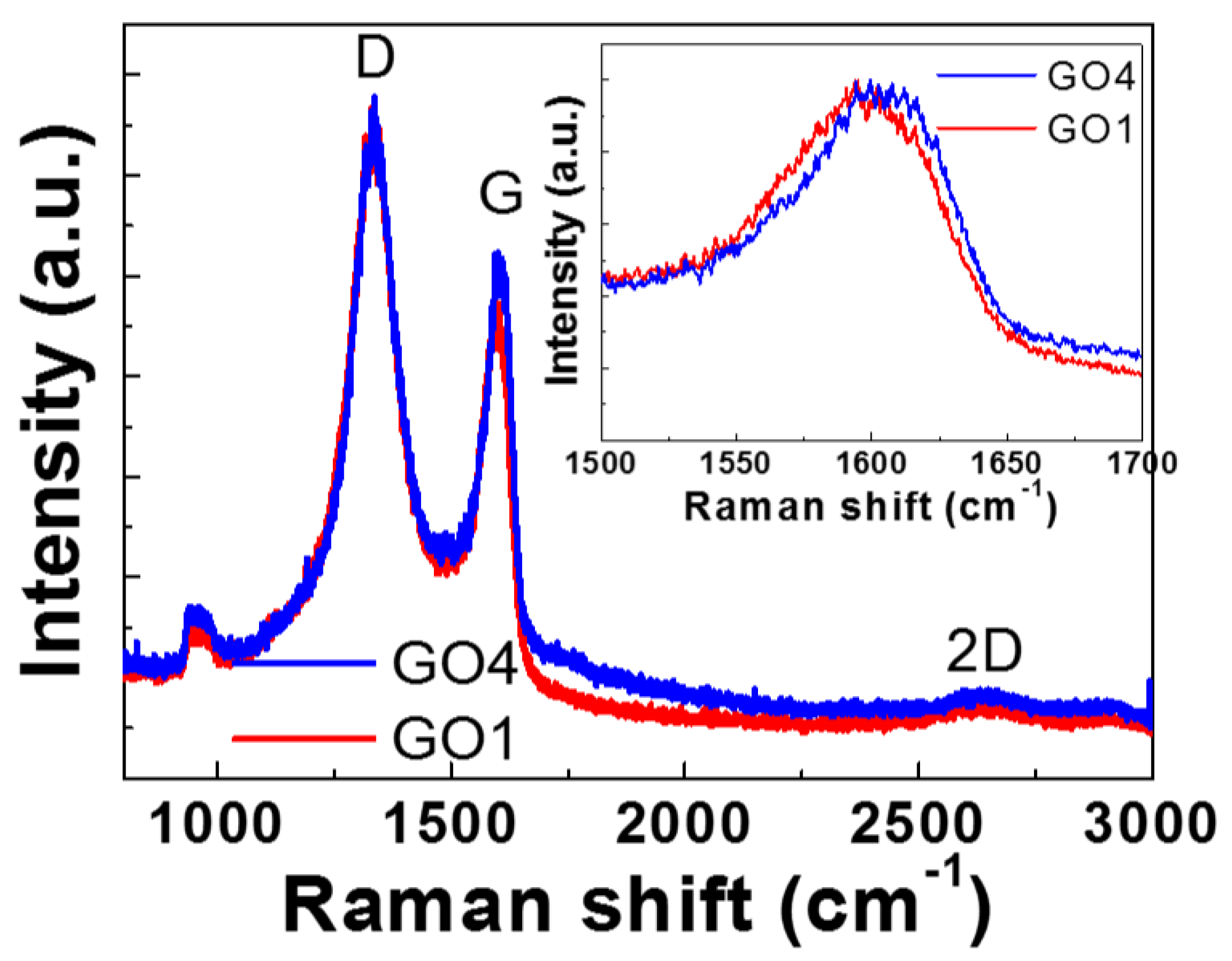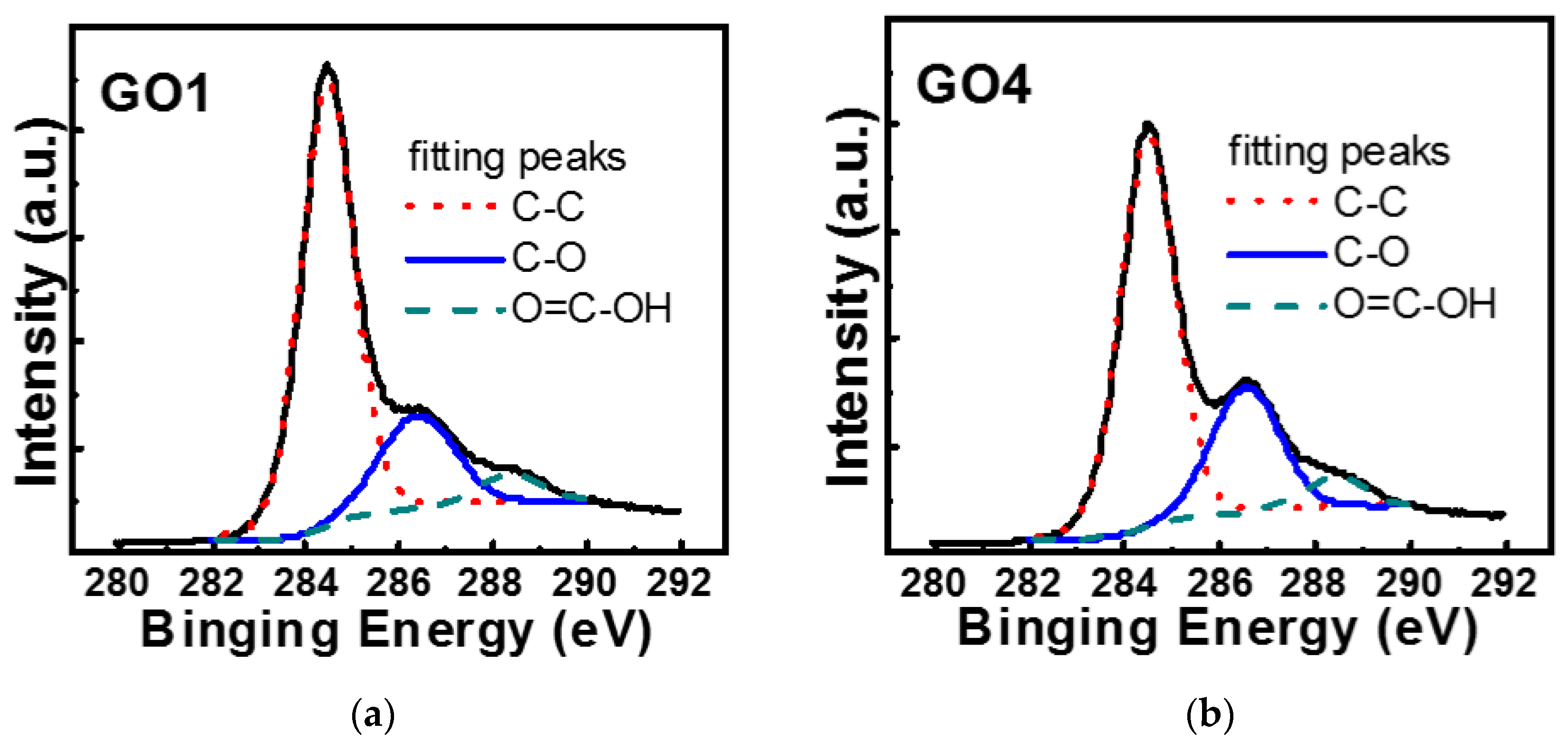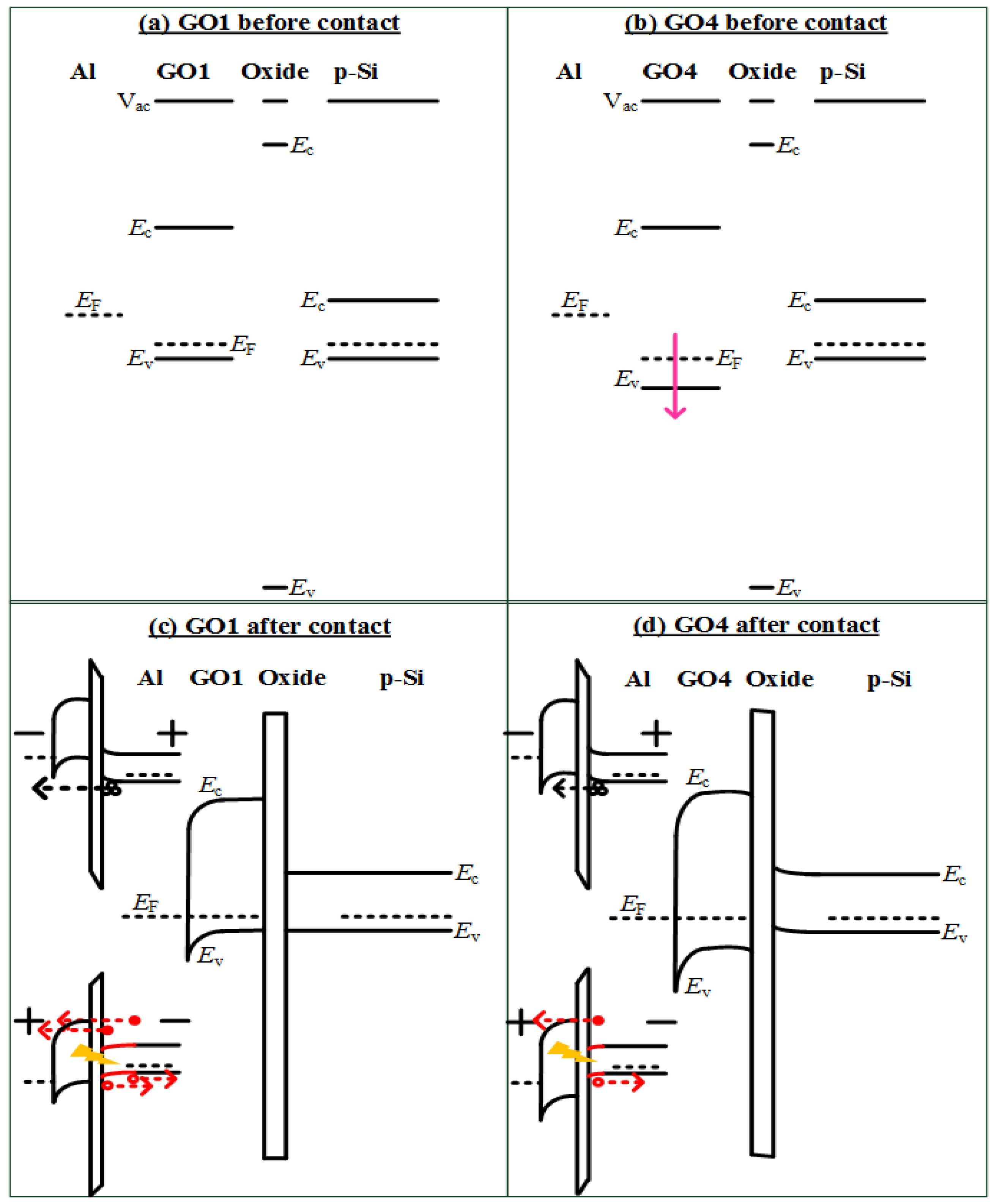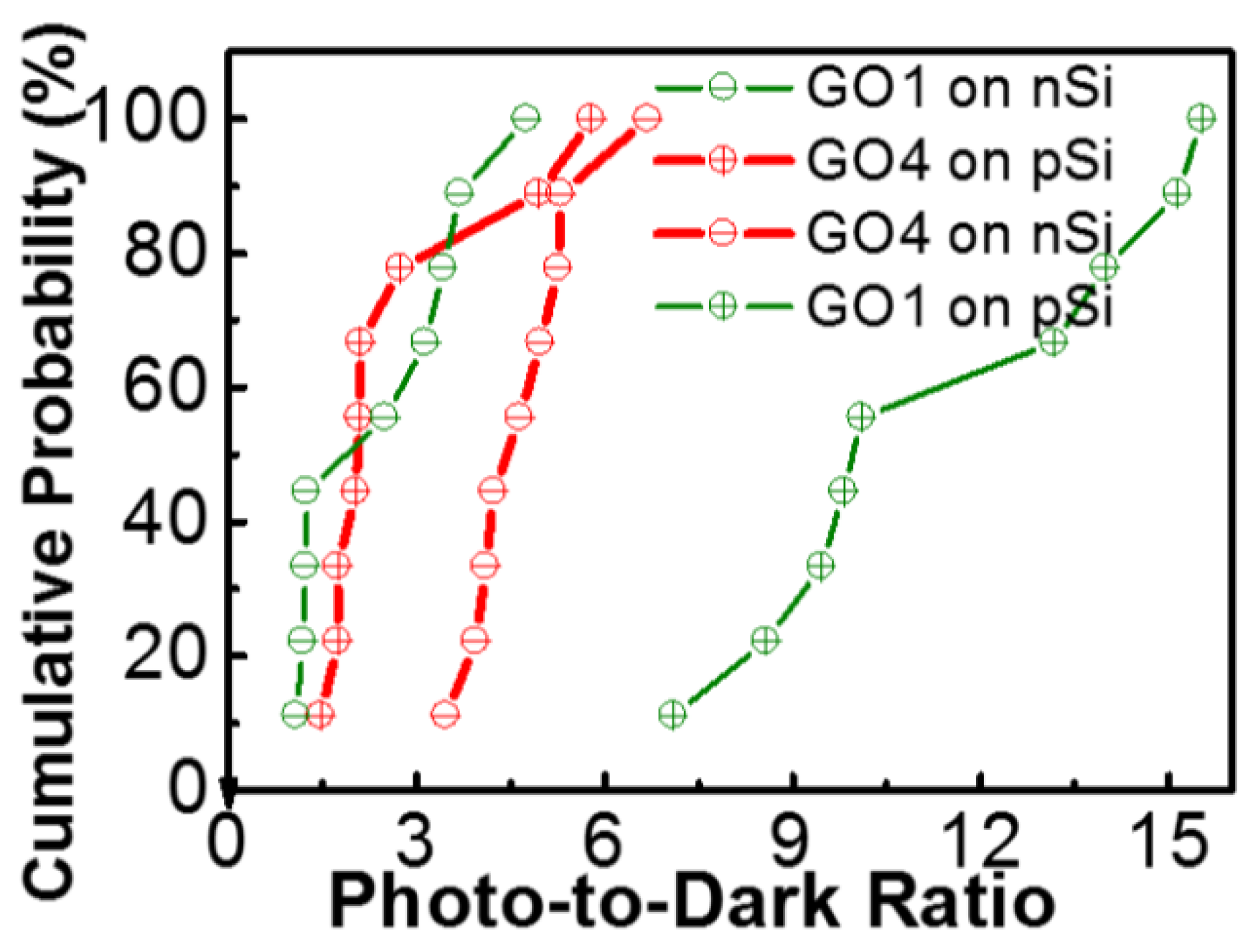Effects of Different Oxidation Degrees of Graphene Oxide on P-Type and N-Type Si Heterojunction Photodetectors
Abstract
:1. Introduction
2. Experiments
3. Characterization of Oxidation Degree
4. Electrical Characteristics
5. Conclusions
Author Contributions
Funding
Acknowledgments
Conflicts of Interest
References
- Ismail, R.A.; Rashid, F.F.; Tariq, M.S. Preparation and characteristics study of CuAlO2/Si heterojunction photodetector by pulsed laser deposition. J. Mater. Sci. Mater. Electron. 2017, 28, 6889–6896. [Google Scholar] [CrossRef]
- Goossens, S.; Navickaite, G.; Monasterio, C.; Gupta, S.; Piqueras, J.J.; Pérez, R.; Burwell, G.; Nikitskiy, I.; Lasanta, T.; Galán, T.; et al. Broadband image sensor array based on graphene–CMOS integration. Nat. Photonics 2017, 11, 366–371. [Google Scholar] [CrossRef] [Green Version]
- Khan, W.; Ajmal, H.M.S.; Khan, F.; Huda, N.U.; Kim, S.D. Induced Photonic Response of ZnO Nanorods Grown on Oxygen Plasma-Treated Seed Crystallites. Nanomaterials 2018, 8, 371. [Google Scholar] [CrossRef] [PubMed]
- Koppens, F.H.L.; Mueller, T.; Avouris, P.; Ferrari, A.C.; Vitiello, M.S.; Polini, M. Photodetectors based on graphene, other two-dimensional materials and hybrid systems. Nat. Nanotechnol. 2014, 9, 780–793. [Google Scholar] [CrossRef]
- Li, X.; Zhu, M.; Du, M.; Lv, Z.; Zhang, L.; Li, Y.; Yang, Y.; Yang, T.; Li, X.; Wang, K.; et al. High Detectivity Graphene-Silicon Heterojunction Photodetector. Small 2016, 12, 595–601. [Google Scholar] [CrossRef] [PubMed]
- Casalino, M.; Sassi, U.; Goykhman, I.; Eiden, A.; Lidorikis, E.; Milana, S.; Fazio, D.D.; Tomarchio, F.; Iodice, M.; Coppola, G.; et al. Vertically Illuminated, Resonant Cavity Enhanced, Graphene–Silicon Schottky Photodetectors. ACS Nano 2017, 11, 10955–10963. [Google Scholar] [CrossRef] [PubMed] [Green Version]
- Luongo, G.; Giubileo, F.; Genovese, L.; Iemmo, L.; Martucciello, N.; Di Bartolomeo, A. I-V and C-V Characterization of a High-Responsivity Graphene/Silicon Photodiode with Embedded MOS Capacitor. Nanomaterials 2017, 7, 158. [Google Scholar] [CrossRef] [PubMed]
- Chandrakalavathi, T.; Peta, K.R.; Jeyalakshmi, R. Enhanced UV photoresponse with Au nanoparticles incorporated rGO/Si heterostructure. Mater. Res. Express 2018, 5, 025011. [Google Scholar] [CrossRef] [Green Version]
- Azmi, S.N.C.; Rahman, S.F.A.; Nawabjan, A.; Hashim, A.M. Junction properties analysis of silicon back-to-back Schottky diode with reduced graphene oxide Schottky electrodes. Microelectron. Eng. 2018, 196, 32–37. [Google Scholar] [CrossRef]
- Dehkharghani, M.N.; Rajabi, A.; Amirmazlaghani, A. Responsivity improvement of Si-based NIR photodetector using reduced Graphene Oxide. In Proceedings of the 2017 Iranian Conference on Electrical Engineering (ICEE), Tehran, Iran, 2–4 May 2017; pp. 523–526. [Google Scholar] [CrossRef]
- Casalino, M. Design of Resonant Cavity-Enhanced Schottky Graphene/Silicon Photodetectors at 1550 nm. J. Lightwave Technol. 2018, 36, 1766–1774. [Google Scholar] [CrossRef]
- Wan, X.; Xu, Y.; Guo, H.; Shehzad, K.; Ali, A.; Liu, Y.; Yang, J.; Dai, D.; Telin, C.; Liu, L.; et al. A self-powered high-performance graphene/silicon ultraviolet photodetector with ultra-shallow junction: Breaking the limit of silicon? npj 2D Mater. Appl. 2017, 1, 4. [Google Scholar] [CrossRef]
- Wang, L.; Jie, J.; Shao, Z.; Zhang, Q.; Zhang, X.; Wang, Y.; Sun, Z.; Lee, S. MoS2/Si Heterojunction with Vertically Standing Layered Structure for Ultrafast, High-Detectivity, Self-Driven Visible–Near Infrared Photodetectors. Adv. Funct. Mater. 2015, 25, 2910–2919. [Google Scholar] [CrossRef]
- Han, K.I.; Kim, S.; Lee, I.G.; Kim, J.P.; Kim, J.H.; Hong, S.W.; Cho, B.J.; Hwang, W.S. Compliment Graphene Oxide Coating on Silk Fiber Surface via Electrostatic Force for Capacitive Humidity Sensor Applications. Sensors 2017, 17, 407. [Google Scholar] [CrossRef] [PubMed]
- Singh, M.; Kumar, G.; Prakash, N.; Khanna, S.P.; Pal, P.; Singh, S.P. Large bandgap reduced graphene oxide (rGO) based n-p + heterojunction photodetector with improved NIR performance. Semiconduct. Sci. Technol. 2018, 33, 045012. [Google Scholar] [CrossRef] [Green Version]
- Son, S.B.; Huang, F.; Bae, T.S.; Hong, W.K. Wettability effects of graphene oxide aqueous solution in photodetectors based on graphene oxide/silicon heterojunctions via ultraviolet ozone treatment. J. Alloys Compd. 2017, 698, 384–389. [Google Scholar] [CrossRef]
- Ahmad, H.; Thandavan, T.M.K. Characterization of graphene oxide/silicon dioxide/p-type silicon heterojunction photodetector towards infrared 974 nm illumination. Opt. Quantum Electron. 2017, 49, 395. [Google Scholar] [CrossRef]
- Maiti, R.; Manna, S.; Midya, A.; Ray, S.K. Broadband photoresponse and rectification of novel graphene oxide/n-Si heterojunctions. Opt. Express 2013, 21, 26034–26043. [Google Scholar] [CrossRef] [PubMed]
- Kalita, G.; Wakita, K.; Umeno, M.; Tanemura, M. Fabrication and characteristics of solution-processed graphene oxide-silicon heterojunction. Phys. Status Solidi Rapid Res. Lett. 2013, 7, 340–343. [Google Scholar] [CrossRef]
- Yeh, T.F.; Chan, F.F.; Hsieh, C.T.; Teng, H. Graphite Oxide with Different Oxygenated Levels for Hydrogen and Oxygen Production from Water under Illumination: The Band Positions of Graphite Oxide. J. Phys. Chem. C 2011, 115, 22587–22597. [Google Scholar] [CrossRef]
- Lin, C.H.; Yeh, W.T.; Chan, C.H.; Lin, C.C. Influence of graphene oxide on metal-insulator-semiconductor tunneling diodes. Nanoscale Res. Lett. 2012, 7, 343. [Google Scholar] [CrossRef] [PubMed]
- Lin, C.H.; Yeh, W.T.; Chen, M.H. Metal-Insulator-Semiconductor Photodetectors with Different Coverage Ratios of Graphene Oxide. IEEE J. Sel. Top. Quantum Electron. 2014, 20, 3800105. [Google Scholar] [CrossRef]
- Haluška, M.; Obergfell, D.; Meyer, J.C.; Scalia, G.; Ulbricht, G.; Krauss, B.; Chae, D.H.; Lohmann, T.; Lebert, M.; Kaempgen, M.; et al. Investigation of the shift of Raman modes of graphene flakes. Phys. Stat. Solidi B 2007, 244, 4143–4146. [Google Scholar] [CrossRef]
- Karthick, S.; Lee, H.S.; Kwon, S.J.; Natarajan, R.; Saraswathy, V. Standardization, Calibration, and Evaluation of Tantalum-Nano rGO-SnO2 Composite as a Possible Candidate Material in Humidity Sensors. Sensors 2016, 16, 2079. [Google Scholar] [CrossRef] [PubMed]
- Kudin, K.N.; Ozbas, B.; Schniepp, H.C.; Prud’homme, R.K.; Aksay, I.A.; Car, R. Raman Spectra of Graphite Oxide and Functionalized Graphene Sheets. Nano Lett. 2008, 8, 36–41. [Google Scholar] [CrossRef] [PubMed]
- Kim, M.; Safron, N.S.; Han, E.; Arnold, M.S.; Gopalan, P. Electronic Transport and Raman Scattering in Size-Controlled Nanoperforated Graphene. ACS Nano 2012, 6, 9846–9854. [Google Scholar] [CrossRef] [PubMed]
- Krishnamoorthy, K.; Veerapandian, M.; Yun, K.; Kim, S.J. The chemical and structural analysis of graphene oxide with different degrees of oxidation. Carbon 2013, 53, 38–49. [Google Scholar] [CrossRef]
- Dreyer, D.R.; Park, S.; Bielawski, C.W.; Ruoff, R.S. The chemistry of graphene oxide. Chem. Soc. Rev. 2010, 39, 228–240. [Google Scholar] [CrossRef] [PubMed]
- Yang, D.; Velamakanni, A.; Bozoklu, G.; Park, S.; Stoller, M.; Piner, R.D.; Stankovich, S.; Jung, I.; Field, D.A.; Ventrice, C.A., Jr.; et al. Chemical analysis of graphene oxide films after heat and chemical treatments by X-ray photoelectron and Micro-Raman spectroscopy. Carbon 2009, 47, 145–152. [Google Scholar] [CrossRef]








© 2018 by the authors. Licensee MDPI, Basel, Switzerland. This article is an open access article distributed under the terms and conditions of the Creative Commons Attribution (CC BY) license (http://creativecommons.org/licenses/by/4.0/).
Share and Cite
Shih, C.-K.; Ciou, Y.-T.; Chiu, C.-W.; Li, Y.-R.; Jheng, J.-S.; Chen, Y.-C.; Lin, C.-H. Effects of Different Oxidation Degrees of Graphene Oxide on P-Type and N-Type Si Heterojunction Photodetectors. Nanomaterials 2018, 8, 491. https://doi.org/10.3390/nano8070491
Shih C-K, Ciou Y-T, Chiu C-W, Li Y-R, Jheng J-S, Chen Y-C, Lin C-H. Effects of Different Oxidation Degrees of Graphene Oxide on P-Type and N-Type Si Heterojunction Photodetectors. Nanomaterials. 2018; 8(7):491. https://doi.org/10.3390/nano8070491
Chicago/Turabian StyleShih, Ching-Kuei, Yu-Tang Ciou, Chun-Wei Chiu, Yu-Ru Li, Jia-Syun Jheng, Yen-Chun Chen, and Chu-Hsuan Lin. 2018. "Effects of Different Oxidation Degrees of Graphene Oxide on P-Type and N-Type Si Heterojunction Photodetectors" Nanomaterials 8, no. 7: 491. https://doi.org/10.3390/nano8070491



